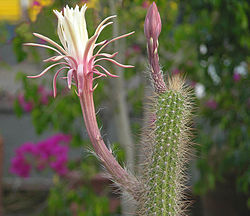Peniocereus: Difference between revisions
m moved Nyctocereus to Peniocereus: per wp |
No edit summary |
||
| Line 1: | Line 1: | ||
{{SPlantbox | {{SPlantbox | ||
|familia=Cactaceae | |familia=Cactaceae | ||
|genus= | |genus=Peniocereus | ||
|taxo_author=(A.Berger) Britton & Rose | |taxo_author=(A.Berger) Britton & Rose | ||
|habit=cacti-succulent | |habit=cacti-succulent | ||
| Line 14: | Line 14: | ||
{{Inc| | {{Inc| | ||
Nyctocereus (night and cereus). Cactaceae. A slender cactus, at first erect, then clambering, with few branches; the st. has many low ribs with closely set areoles producing 10 or more acicular spines: fls. large, nocturnal, white; tube and ovary covered with small bracts, producing in their axils small clusters of spines: fr. red; seeds black.—Several species are known. They are among the several kinds of night-blooming cereus. See Succulents. | Nyctocereus (night and cereus). Cactaceae. A slender cactus, at first erect, then clambering, with few branches; the st. has many low ribs with closely set areoles producing 10 or more acicular spines: fls. large, nocturnal, white; tube and ovary covered with small bracts, producing in their axils small clusters of spines: fr. red; seeds black.—Several species are known. They are among the several kinds of night-blooming cereus. See Succulents. | ||
}} | |||
{{Inc| | |||
Peniocereus (Latin combination, meaning phalloid Cereus). Cactaceae. Low slender erect plants, growing from very large fleshy turnip-shaped roots: sts. usually 4- or 5-ribbed: fls. large, nocturnal, usually white: fr. ovoid, long-acuminate, bright scarlet, edible. | |||
{{SCH}} | |||
}} | }} | ||
Latest revision as of 17:37, 22 February 2010
| Peniocereus subsp. var. | ||||||||||||||||||||||||||||||||||||||||||||||||||||||||
|---|---|---|---|---|---|---|---|---|---|---|---|---|---|---|---|---|---|---|---|---|---|---|---|---|---|---|---|---|---|---|---|---|---|---|---|---|---|---|---|---|---|---|---|---|---|---|---|---|---|---|---|---|---|---|---|---|

|
|
| ||||||||||||||||||||||||||||||||||||||||||||||||||||||
| ||||||||||||||||||||||||||||||||||||||||||||||||||||||||
Peniocereus is a genus of vining cacti, comprising about 18 species, found from the southwestern United States and Mexico. They have a large underground tuber, thin and inconspicuous stems.
| Standard Cyclopedia of Horticulture |
|---|
|
Nyctocereus (night and cereus). Cactaceae. A slender cactus, at first erect, then clambering, with few branches; the st. has many low ribs with closely set areoles producing 10 or more acicular spines: fls. large, nocturnal, white; tube and ovary covered with small bracts, producing in their axils small clusters of spines: fr. red; seeds black.—Several species are known. They are among the several kinds of night-blooming cereus. See Succulents.
|
| Standard Cyclopedia of Horticulture |
|---|
|
Peniocereus (Latin combination, meaning phalloid Cereus). Cactaceae. Low slender erect plants, growing from very large fleshy turnip-shaped roots: sts. usually 4- or 5-ribbed: fls. large, nocturnal, usually white: fr. ovoid, long-acuminate, bright scarlet, edible. CH
|
Cultivation
Propagation
Pests and diseases
Species
Peniocereus greggii - desert nightblooming cereus
Peniocereus marianus
Peniocereus zopilotensis
The following genera have been brought into synonymy with Peniocereus:
- Cullmannia Distefano
- Neoevansia W.T.Marshall
- Nyctocereus (A.Berger) Britton & Rose
Gallery
-
photo 1
-
photo 2
-
photo 3
References
- Standard Cyclopedia of Horticulture, by L. H. Bailey, MacMillan Co., 1963
External links
- w:Peniocereus. Some of the material on this page may be from Wikipedia, under the Creative Commons license.
- Peniocereus QR Code (Size 50, 100, 200, 500)
